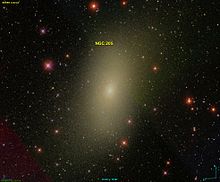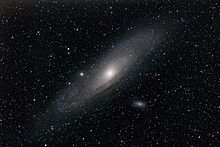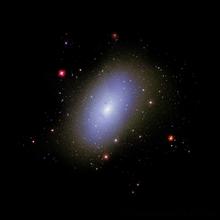| Messier 110[1] | |
|---|---|
 SDSS image of Messier 110/NGC 205 | |
| Observation data (J2000 epoch) | |
| Constellation | Andromeda[2] |
| Right ascension | 00h 40m 22.05446s[3] |
| Declination | +41° 41′ 07.4963″[3] |
| Redshift | −0.000804±0.000010[4] |
| Helio radial velocity | −241±3[4] |
| Galactocentric velocity | −62±8[4] |
| Apparent magnitude (V) | 8.92[4] |
| Characteristics | |
| Type | E5 pec[5] |
| Apparent size (V) | 21′.9 × 11′.0[4] |
| Other designations | |
| IRAS 00376+4124, LEDA 2429, M110, MCG +07-02-014, NGC 0205, PGC 002429[6] | |
Messier 110, or M110, also known as NGC 205, is a dwarf elliptical galaxy that is a satellite of the Andromeda Galaxy in the Local Group.[7]
Early observational history
Charles Messier never included the galaxy in his list, but it was depicted by him, together with M32, on a drawing of that, more recently known as the Andromeda Galaxy (the latter descriptor not being in use for such objects in that century); the label of the drawing evinces that Messier first saw the object in 1773.[a][8] The galaxy was independently discovered by Caroline Herschel on August 27, 1783; her brother William Herschel described her discovery in 1785.[b][8][9] The suggestion to assign the galaxy a Messier number was made by Kenneth Glyn Jones in 1967,[10] making it the last member of the Messier List.
Properties
This galaxy has a morphological classification of pec dE5, indicating a dwarf elliptical galaxy with a flattening of 50%. It is designated peculiar (pec) due to patches of dust and young blue stars near its center.[11] This is unusual for dwarf elliptical galaxies in general,[7] and the reason is unclear.[11] Unlike M32, M110 lacks evidence for a supermassive black hole at its center.[12]
The interstellar dust in M110 has a mass of (1.1–1.8)×104 M☉ with a temperature of 18–22 K, and the interstellar gas has (4–7)×106 M☉. The inner region has sweeping deficiencies in its interstellar medium IM, most likely expelled by supernova explosions. Tidal interactions with M31 may have stripped away a significant fraction of the expelled gas and dust, leaving the galaxy as a whole, as it presents, deficient in its IM density.[13]
Novae have been detected in this galaxy, including one discovered in 1999,[14] and another in 2002. The latter, designated EQ J004015.8+414420, had also been captured in images taken by the Sloan Digital Sky Survey (SDSS) that October.[15]
Local context
About half of the Andromeda's satellite galaxies are orbiting it along a highly flattened plane, with 14 out of 16 following the same sense of rotation. One theory proposes that these 16 once belonged to a subhalo surrounding M110, then the group was broken up by tidal forces during a close encounter with Andromeda.[16]
References
- ^ McConnachie, A. W.; et al. (2005). "Distances and metallicities for 17 Local Group galaxies". Monthly Notices of the Royal Astronomical Society. 356 (4): 979–997. arXiv:astro-ph/0410489. Bibcode:2005MNRAS.356..979M. doi:10.1111/j.1365-2966.2004.08514.x.
- ^ Dreyer, J. L. E.; Sinnott, R. W. (1988). Sinnott, R. W. (ed.). NGC 2000.0: The Complete New General Catalogue and Index Catalogues of Nebulae and Star Clusters by J. L. E. Dreyer. Sky Publishing Corporation and Cambridge University Press. ISBN 978-0-933346-51-2.
- ^ a b Brown, A. G. A.; et al. (Gaia collaboration) (August 2018). "Gaia Data Release 2: Summary of the contents and survey properties". Astronomy & Astrophysics. 616. A1. arXiv:1804.09365. Bibcode:2018A&A...616A...1G. doi:10.1051/0004-6361/201833051.
- ^ a b c d e "NASA/IPAC Extragalactic Database". Results for NGC 205. Retrieved 2006-11-29.
- ^ Batcheldor, D.; et al. (September 2013). "An STIS Atlas of Ca II Triplet Absorption Line Kinematics in Galactic Nuclei". The Astronomical Journal. 146 (3): 10. arXiv:1308.1983. Bibcode:2013AJ....146...67B. doi:10.1088/0004-6256/146/3/67. S2CID 59246892. 67.
- ^ "M 110". SIMBAD. Centre de données astronomiques de Strasbourg. Retrieved 2009-12-19.
- ^ a b Sandage, A.; Bedke, J. (1994). Carnegie Atlas of Galaxies. Carnegie Institution of Washington. ISBN 978-0-87279-667-6.
- ^ a b Jones, K. G. (1991). Messier's Nebulae and Star Clusters (2nd ed.). Cambridge University Press. ISBN 978-0-521-37079-0.
- ^ Herschel, William (1785). "On the construction of the heavens". Philosophical Transactions of the Royal Society of London. 75: 213–266. From p. 262: "There is a very considerable, broad, pretty faint, small nebula near it [the Andromeda galaxy, M31]; my Sister [Caroline] discovered it August 27, 1783, with a Newtonian 2-feet sweeper. It shews the same faint colour with the great one, and is, no doubt, in the neighborhood of it. It is not [M32] … ; but this is about two-thirds of a degree north preceding it, in a line parallel to β [Beta] and ν [Nu] Andromedae."
- ^ Jones, K. G. (1967). "Some New Notes on Messier's Catalogue". Sky & Telescope. 33: 156–158. Bibcode:1967S&T....33..156J.
- ^ a b Ford, Holland C.; et al. (July 1973), "Planetary Nebulae in Local-Group Galaxies. I. Identifications in NGC 185, NGC 205, and NGC 221", Astrophysical Journal, 183: L73, Bibcode:1973ApJ...183L..73F, doi:10.1086/181255
- ^ Valluri, M.; et al. (2005). "The Low End of the Supermassive Black Hole Mass Function: Constraining the Mass of a Nuclear Black Hole in NGC 205 via Stellar Kinematics". The Astrophysical Journal. 628 (1): 137–152. arXiv:astro-ph/0502493. Bibcode:2005ApJ...628..137V. doi:10.1086/430752. S2CID 16397125.
- ^ De Looze, I.; et al. (July 2012). "Herschel and JCMT observations of the early-type dwarf galaxy NGC 205". Monthly Notices of the Royal Astronomical Society. 423 (3): 2359–2373. arXiv:1204.1264. Bibcode:2012MNRAS.423.2359D. doi:10.1111/j.1365-2966.2012.21044.x. S2CID 34911811.
- ^ van den Bergh, S. (2000). "Updated Information on the Local Group". Publications of the Astronomical Society of the Pacific. 112 (770): 529–536. arXiv:astro-ph/0001040. Bibcode:2000PASP..112..529V. doi:10.1086/316548. S2CID 1805423.
- ^ "Forum di Astronomia Amatoriale Italiano".
- ^ Angus, Garry W.; Coppin, Paul; Gentile, Gianfranco; Diaferio, Antonaldo (November 2016). "The potential role of NGC 205 in generating Andromeda's vast thin corotating plane of satellite galaxies". Monthly Notices of the Royal Astronomical Society. 462 (3): 3221–3242. arXiv:1608.03763. Bibcode:2016MNRAS.462.3221A. doi:10.1093/mnras/stw1822. S2CID 56154943.
External links
- Messier 110 Data Sheed and additional information - Telescopius. (Deep Sky Objects Browser has been renamed and reformatted - the old links below no longer work correctly)
- Messier 110 data sheet, altitude charts, sky map and related objects - Deep Sky Objects Browser
- Messier 110 amateur astrophotography - Deep Sky Objects Browser
- Messier 110 on WikiSky: DSS2, SDSS, GALEX, IRAS, Hydrogen α, X-Ray, Astrophoto, Sky Map, Articles and images
- SEDS: Elliptical Galaxy M110
- Fohring, Dora; Merrifield, Michael. "M110 – Dwarf Galaxy". Deep Sky Videos. Brady Haran.

